Pen Mill Athletics Ground
Pen Mill Athletics Ground
aka Pen Mill Football Ground
Although probably best known as Yeovil Town's Pen Mill Football Ground between 1895 and 1920, the ground was officially called the Pen Mill Athletics Ground, hosting a wide range of activities other than football (see Gallery).
Yeovil Football Club was founded in 1890, and shared its ground with Yeovil Rugby Club in West Hendford (playing on alternate Saturdays). This was most almost certainly the ground which became Yeovil's first cricket ground.
In 1895 the current club was founded and named Yeovil Casuals. They played in green and white stripes. At this time they started playing home games at the Pen Mill Athletic Ground, with their headquarters in the Pen Mill Hotel. The club adopted the name Yeovil Town Football Club in 1907, playing in a new strip of green shirts with white cuffs.
In 1908, another football club was formed in Yeovil - Petters United. They played in amber and black and their ground was in Brickyard Lane (today's St Michael's Avenue).
Within a few years, Yeovil Town Football Club and Petters United were playing in the same competitions and a rivalry grew between the two clubs. In 1920, the two teams merged to become Yeovil & Petters United. The amalgamation coincided with a move from the Pen Mill ground to Huish, the first match taking place on 28th August 1920. Yeovil & Petters United was renamed Yeovil Football and Athletic Club Limited in 1923.
|
The
Pen Mill
Football
Riot of
1896
Despite the rudimentary facilities, crowds of more than 1000 were not uncommon for certain Somerset League games, which was the primary league in which the 'Casuals' competed at the time against teams such as Wells City, Wincanton, and the most formidable opponents in the league, Street FC. The 'Casuals' however had quickly developed a rivalry with Radstock FC, a team from the North of the county. The basis of this rivalry could well have been rooted in class differences; Radstock drew players from the local coal mines and working men's clubs, making them the epitome of the 'working man's game,' while the Casuals represented a more refined element of Yeovil. The Casuals boasted players like Gilbert Claude Vassall, a celebrated Oxford blue with a sharp intellect and renowned status as one of the greatest amateur sportsmen in the country. Vassall even played county cricket for Somerset and received a call-up to the full England football squad, perhaps making him one of the greatest players in Yeovil's history. He was adored by the Pen Mill supporters and stood out as the fledgling team's star player. On February 24th, 1896, a determined Radstock arrived at the quaint and busy Pen Mill station to compete in a Somerset Senior cup tie. The match represented the Casuals' sole opportunity to claim highly valued silverware that year. With pride and confidence, Radstock proceeded on the brief two-minute walk to the grandly named Pen Mill Stadium from the station with Captain William Hyman at the helm. Tragically , Ernest Hyman, William's nephew, would meet a tragic fate in 1927 while playing for Yeovil, succumbing to injuries sustained in a match against Taunton. William had every right to stride proudly into the Pen Mill Hotel, to change attire for the match, his team were an exceptional side displaying great talent and speed in attack and built for battle. Referee Mr Praeter from Shepton Mallet signaled the start of the game, and Radstock quickly took the lead, with Strawbridge delivering a fantastic shot that silenced the large crowd that had gathered. The locals were even more displeased when the upstarts from 'up North' attacked again and again and the Casuals 'give and take' style was found to be totally ineffective against the tough no nonsense tactics of Radstock. Soon, the locals had more to moan about. As with a call of 'hands' Radstock were given a free kick just outside the area at the Camborne End, Wyman stepped up and within a flash it was nestling in the back of the net! At 2-0 the locals, who like today, loved a moan, started to get restless as finally Mr Praeter blew his long whistle to signal the players to 'suck lemons' for half time. In those days at half time, the landlord of the Pen Mill, Mr Bennett kindly set up a table of beer at the 'Hotel End' for the locals to quench their hoarse throats, one could say they had it better than present day Glovers fans!
Once the
men, and
daresay
a few
women,
had
sucked
on some
lemons
and
refreshed
themselves
with a
pint or
two at
the beer
table ,
the
anticipated
second
half
commenced
and a
completely
different
game
evolved.
Yeovil,
clearly
energized
with
vitamin
c and
charging
down the
Pen Mill
slope,
launched
a
relentless
assault
on the
Radstock
goal,
with
their
star
player,
the
classy
Vassall
dominating
the
opposition.
As the
arduous
game
continued
with
both
teams
exchanging
blows
both
metaphorically
and
literally
, a
rampant
Yeovil
finally
scored,
a
stunning
shot
courtesy
of none
other
than
that man
Vassall. Yeovil were dominating proceedings, relentlessly charging down the sloping field! The excited crowd were going wild on the Lyde Road side and it was just a matter of time before the 'Green and Whites' equalized and would go on to win!
The
tension
was
palpable
as
Davis,
the
Casuals
main
centre
forward,
took a
hard and
straight
shot
towards
the
Radstock
keeper,
Horler.
Horler
was
right
behind
it and
caught
the ball
tight in
his
grasp
chest
high.
Davis
was not
one to
be
denied
so
easily
though !
He
continued
his run
with
determination,
with a
fair and
game
shoulder
barge,
sent
Horler
and the
ball
straight
into the
goal at
the
Camborne
end!
"GOAL!"
went up
the
shout.
Hats and
caps of
all
designs,
no doubt
thrown
high in
the
bleak
winter
Yeovil
sky, as
the fans
and
players
erupted
as one
in joy
and
celebration
of their
amazing
comeback!
The Yeovil crowd and their beloved players were left in a state of shock as Mr. Praeter, the ref, made the controversial decision to disallow Davis's celebrated goal for being ungentlemanly. This sparked an eruption of utter rage from the fans and players alike , causing what can only be described in today's parlance as "absolute scenes". The unperturbed Mr Praeter's next action only fueled the anger, shock and chaos, as he then swiftly proceeded to send the bemused Davis off the field, as punishment for his ungentlemanly actions during the scoring attempt. There is no record of what transpired for the remainder of the game, except that the spectators 'hooted' Mr. Praeter, at every whistle blown. Obviously a Victorian term to question the referees hereditary lineage and the color of his outfit. What is sure is that come the final whistle, William Hyman's Radstock had pulled off a surprising 2-1 victory against the Pen Mill heroes, depriving the Casuals of their only opportunity to showcase a handsome cup in their new surroundings. Step forward one William Cooper, a young labourer by trade, who can claim notoriety as Yeovil's first football hooligan. Cooper and his friends, a significant group in number, had gathered outside the Pen Mill Hotel to confront the celebrating Radstock team and now the hated Mr. Praeter. The latter had taken refuge inside the hotel and wasn't coming out for love or money. The hard faced burly miners from Radstock were not so scared and finally they stepped outside the front of the hotel only to be immediately pelted with stones. The Radstock players scattered in all directions, were chased into nearby shops and attacked, with Cooper described as now being with coat off wanting to fight all and sundry, leading the charge and fist. With the arrival of substantial police reinforcements, the Radstock team and Mr. Praeter were collected, protected were guided down the sloping road to the station. The walk for Hyman and his Radstock team , which had taken them only two minutes earlier in the afternoon, now seemed to stretch on endlessly as the baying mob trailed behind them. For their protection, the now bruised and battered group were placed in a carriage on the upline platform at Pen Mill which had been specially cleared for them. Finally, and no doubt thankful to leave, they headed home to North Somerset. As a consequence of the infamous riot, the Somerset FA imposed a fine on Yeovil. With Davis and another player being put on notice regarding their conduct in the future. William Cooper, who had finally been arrested, was fined £5 for his troubles, a substantial amount, and required to pledge to maintain the peace. Additionally, Yeovil were instructed to post signs throughout the ground and hotel warning rowdy spectators of their future behavior and strong language. A fortnight after the incident , Captain William Hyman of Radstock came back to Pen Mill to play in a prestigious county match between Somerset and Devon, which drew a crowd of 2000 spectators.
What an
extremely
brave
man! |
MAP
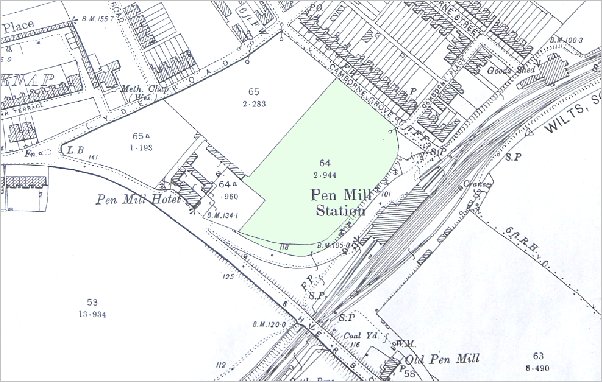
The 1903 Ordnance Survey showing the Pen Mill Athletics Ground coloured green.
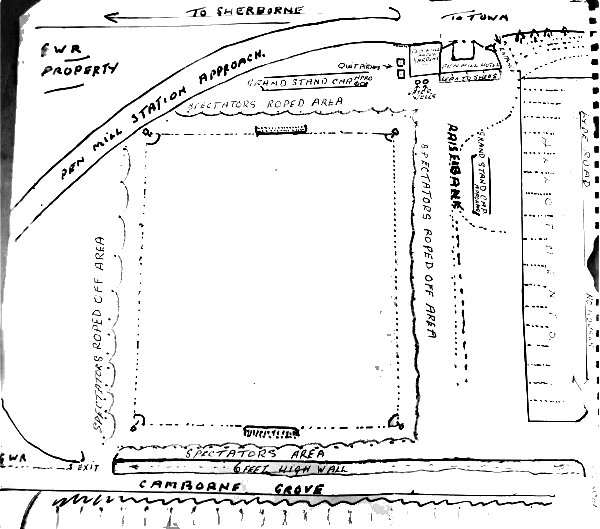
Courtesy of
Michael West
Many thanks to Michael West for the following "While digging through some research at the Somerset Heritage Centre recently, I stumbled across a fascinating find – a hand-drawn plan of the ground’s layout. It looks as though it was sketched from memory, as the grandstand on the Lyde Road side is shown slightly further down than it actually was. Still, it offers a wonderful glimpse into how the ground was once arranged, giving us a sense of how it looked."
Note that the entrance to the ground is at the top right of the plan, to the west of the Pen Mill Hotel. The gates survive today (see the last photo on this page). The exit from the ground into Camborne Grove, is at the bottom left of the plan.
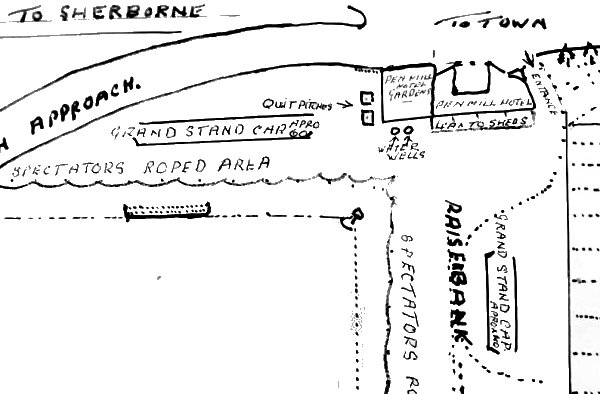
Courtesy of
Michael West
An enlargement of the above plan, showing the area around the Pen Mill Hotel.
gallery
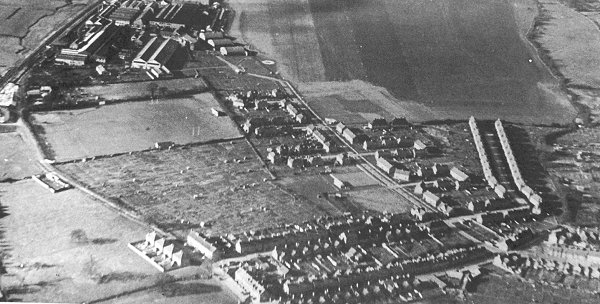
This is a 1938 aerial photograph. At top left is the Westland complex with West Hendford - at this time only a stony track - running across the lower left corner. The field between the allotments and the Westland factory complex is believed to be the ground shared by Yeovil Football Club and Yeovil Rugby Club from 1890 to 1895. It was later the Somerset County Cricket Ground.
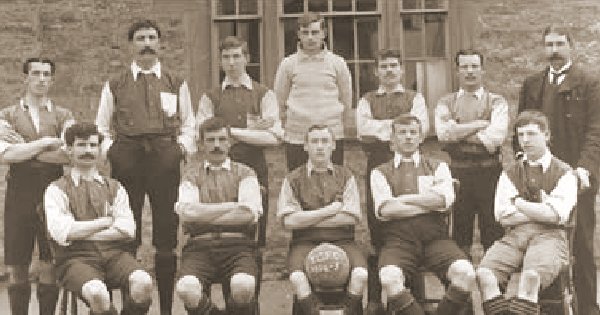
The Yeovil Casuals team of 1904-05 season. At this time they played home games at the Pen Mill Athletic Ground.
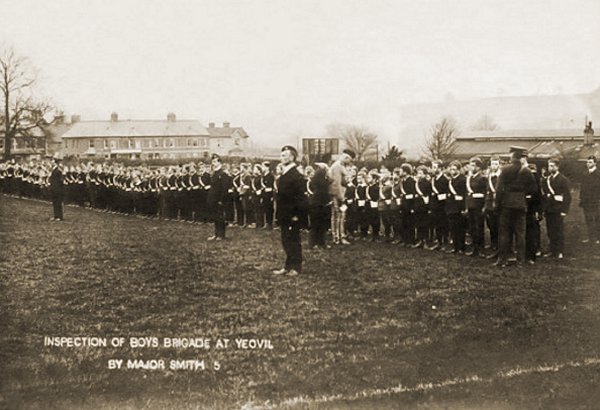
Courtesy of Jack
Sweet
An inspection of Yeovil Boys' Brigade by the founder of the organisation, Major William Alexander Smith, at Pen Mill Athletics Ground in 1905.
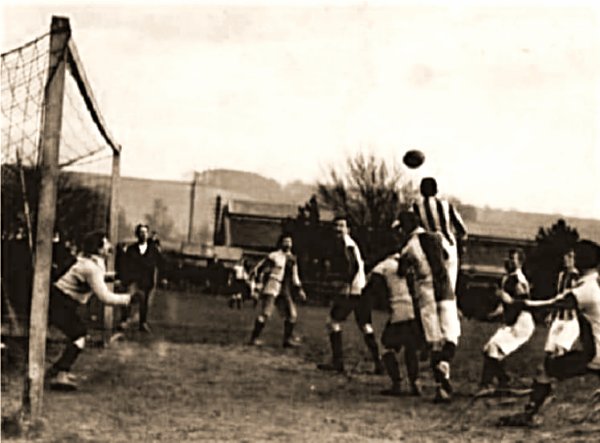
Courtesy
of
Michael
West
Taken in 1909, this is one of the earliest known photographs of a football match at the Pen Mill Athletics Ground, looking south towards Babylon Hill.
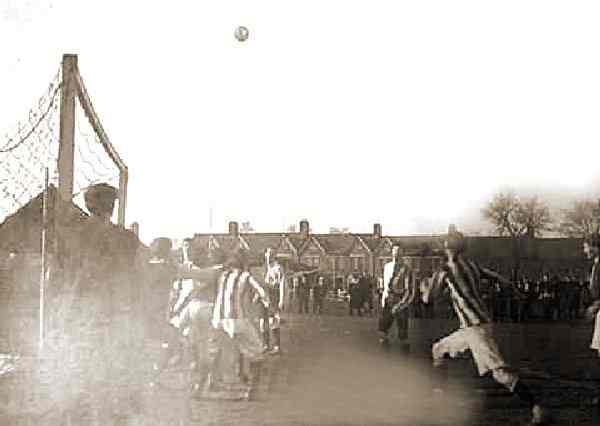
Courtesy
of
Michael
West
Probably from the same match as above, this view looks north towards Camborne Grove.
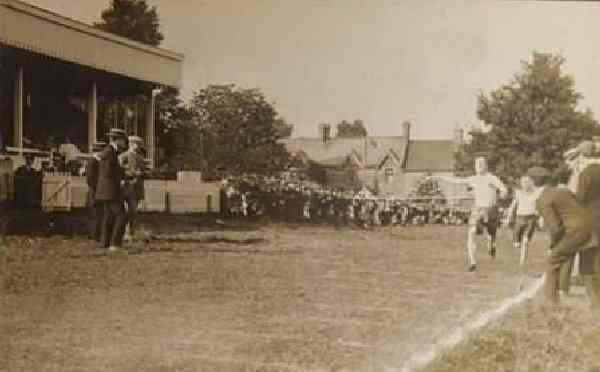
Courtesy
of
Michael
West
Petter's Sports Day, 23 July 1910, showing the 440 yards flat final. The event was held at the Pen Mill Athletics Ground.
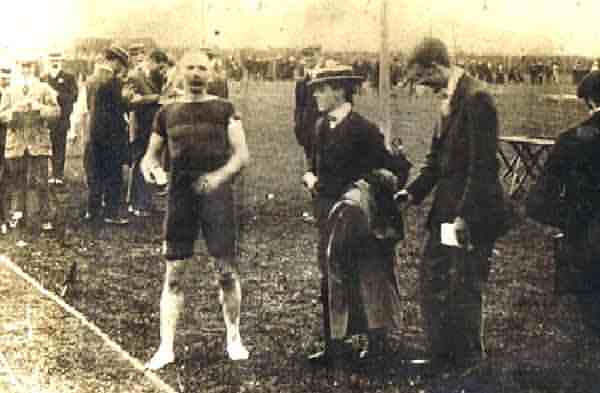
Courtesy
of Tony
Robins
Tony Robins' grandfather, Nat Robins (in the shorts), - winner of a race at the Petter's Sports Day, 23 July 1910.
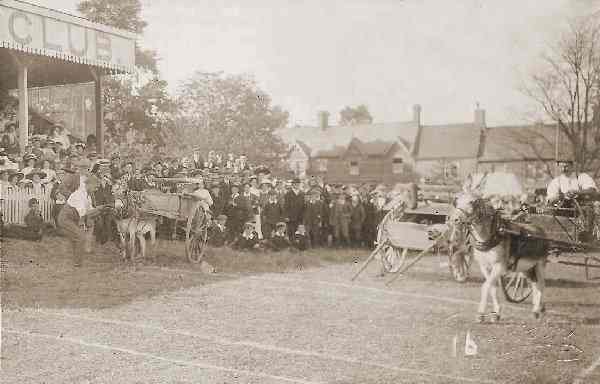
Donkey racing in the Pen Mill Athletics Ground photographed by Witcomb & Son around 1910. In the background are the houses of Camborne Grove (which remain today).
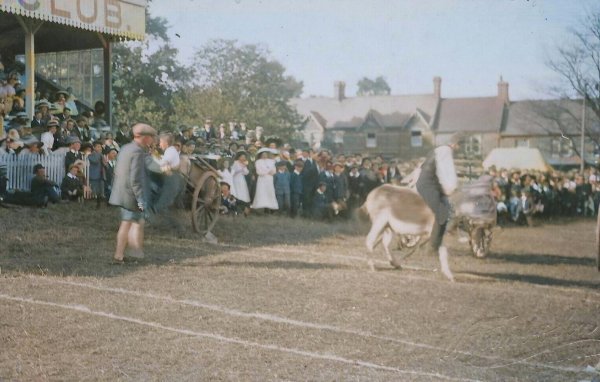
... and another Witcomb photograph (colourised) from the same event.
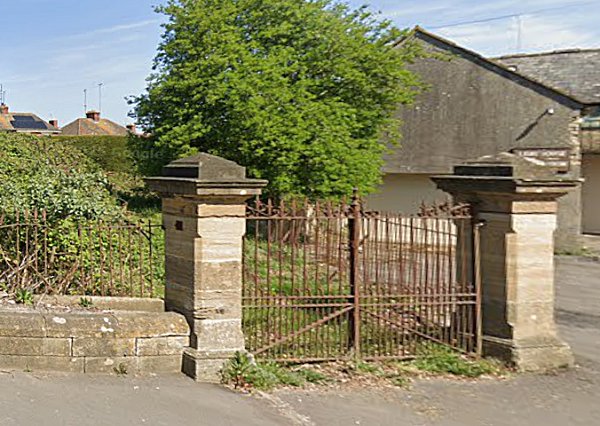
The original entrance to the ground survives today, facing Sherborne Road and just west of the Pen Mill Hotel.